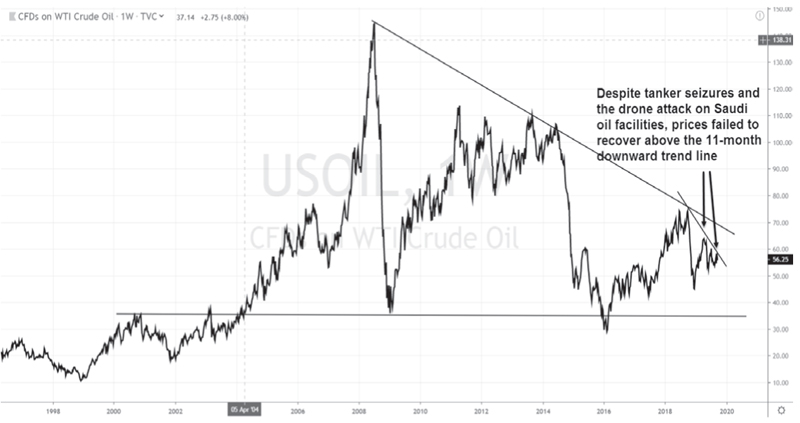Lower oil prices — bullish for the Philippines

In our article three weeks ago, we cited lower crude oil prices as one of the key reasons to remain bullish on the Philippines (see Bullish on the Philippines, Sept. 9). The decline of oil prices helped ease inflation pressures and tempered the country’s current account and trade deficits. These, in turn, contributed to the stability of the Philippine peso and enabled the BSP to cut key interest rates for the third time this year.
BSP lowers inflation target for 2019, 2020
Last week, the BSP lowered its inflation forecasts for 2019 and 2020 to 2.5 percent and 2.9 percent, respectively. BSP’s economic team cited slower global economic growth, as well as low crude oil prices, as the basis for their reduced inflation projections. The Philippine inflation rate, which peaked at 6.7 percent in October of 2018 dropped to a 31-month low of 1.7 percent last August.
A long-term perspective on oil prices
Since oil prices peaked at $147 per barrel in 2008, it has been on a decade-long decline. It fell to the $30-$35 levels twice (2009 and 2016). From these levels, oil prices rebounded and formed lower highs of $110 in 2011-2014 and $75 in 2018. Since 2015, oil prices have remained on the lower half of the 11-year $30-$140 price range.
Source: Tradingview.com, Wealth Securities Research
US shale oil – the game changer
Shale oil fracking has been the game changer this past decade. With advances in fracking technology, the US, which previously was the biggest oil importer in the world, is now self-sufficient. Over the last decade alone, advances in shale oil production have enabled the US to increase its oil output from 5.4 million barrels per day to 12.3 million barrels per day.
EIA, IEA and OPEC forecast lower oil prices
All three of the major oil organizations (EIA, IEA and OPEC) see lower oil prices going forward. In its latest energy outlook, the US Energy Information Administration (EIA) reduced its 2019 and 2020 price forecasts on West Texas Intermediate and Brent crude oil. EIA cited the continued decline in global manufacturing Purchasing Manager’s Indices (PMIs), which is a leading indicator of economic growth.
In its monthly oil market report, the Organization of Petroleum Exporting Countries (OPEC) cut its oil demand growth forecast in 2020 by 60,000 barrels per day (BPD) to 1.08 million BPD. OPEC pointed out the continuation of the US-China trade dispute and the ongoing slowdown in major economies as the reasons for lowering its oil demand forecast.
Huge oil surplus projected for 2020
Despite production cuts by OPEC and the drop in Iran and Venezuelan output due to sanctions, there is a growing surplus in the oil market led by non-OPEC oil. According to the International Energy Agency (IEA), the US had been the main driver of oil supply growth this year, briefly overtaking Saudi Arabia as the world’s top oil exporter in June. Brazil and Norway also expanded their production this year, adding to the considerable oil surplus well into 2020.
Oil price spikes were short-lived
Geopolitical risk also plays a part in the pricing of crude oil. In recent months, several high-profile incidents have increased tensions in the Middle East. Attacks on oil tankers, tanker seizures and most recently, a drone attack on Saudi Arabia’s oil infrastructure, have increased the geopolitical risk premium of oil. However, while it led to heightened volatility, the effects so far have proven to be transitory, and the price spikes were short-lived.
Saudi restores oil production capacity
Oil futures spiked as much as 20 percent during the aftermath of the drone strike last Sept. 14. Today, the prices are back to the levels before the attack as Saudi Arabia restores oil production capacity to 11.3 million barrels per day – the level before the attacks on its oil facilities.
Crude prices remain in a long-term downtrend
Despite the rise in geopolitical risk, oil prices have failed to recover above the 11-month downward trend line. From its most recent peak of $76.88 per barrel in October 2018, WTI crude prices are down 27 percent, while the Asian benchmark Dubai crude is down 28 percent to $60.72 per barrel over the same period.
It appears that the market is less worried about the rising geopolitical tensions and is focused more on the global oil supply-demand outlook. Given the weak demand and the supply surplus, low crude oil prices will likely persist. Lower oil prices, low inflation, and a steady peso mean more room for the BSP to cut rates to ease financial conditions and sustain economic growth.
Philequity Management is the fund manager of the leading mutual funds in the Philippines. Visit www.philequity.net to learn more about Philequity’s managed funds or to view previous articles. For inquiries or to send feedback, please call (02) 689-8080 or email [email protected].
- Latest
- Trending




























